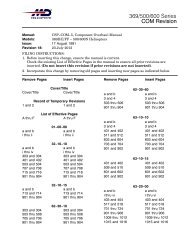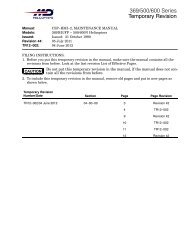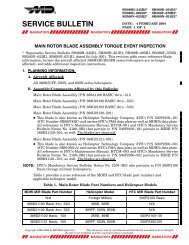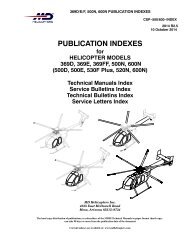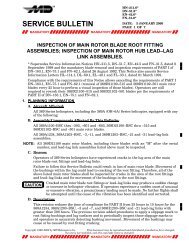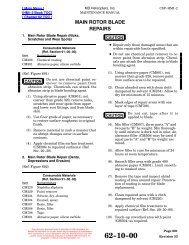TEMPORARY REVISION - MD Helicopters
TEMPORARY REVISION - MD Helicopters
TEMPORARY REVISION - MD Helicopters
Create successful ePaper yourself
Turn your PDF publications into a flip-book with our unique Google optimized e-Paper software.
CSP−H−2<strong>MD</strong> <strong>Helicopters</strong>, Inc.500 Series − Basic HMI5. Battery Handling and ServicingPrecautionsThe electrolyte used in nickel−cadmiumbatteries con-WARNINGtains potassium hydroxide, a casuisticchemical agent. Serious burns will resultif the electrolyte contacts skin. Explosivegases may be released from thebattery during charging. Before removingthe battery from the helicopter,make sure that the power selectorswitch is in the OFF position. Removalor installation of the battery connectorwhile the battery is under load may resultin explosions, electrical arcing orpossible severe personal burns.(1). Satisfactory battery operation is largelydependent upon proper operation of thehelicopter voltage regulator. Batteryproblems may often be prevented oreliminated by maintaining the voltageregulator setting at the precise voltagespecified.(2). Nickel−cadmium batteries contain anelectrolyte mixture of potassiumhydroxide and distilled water. Chemically,this is just the opposite of an acid.Take every possible step to keep thenickle−cadmium battery as far away aspossible from the lead−acid type ofbattery. Do not use the same tools andmaterials (screwdrivers, wrenches,syringes, gloves, apron, etc.) for bothtypes of batteries. Anything associatedwith the lead−acid battery, even the air,must never come in contact with thenickel−cadmium battery or its electrolyte.Even a trace of sulfuric acid fumesfrom a lead−acid battery may result indamage to the nickel−cadmium battery.(3). A low electrolyte does not necessarilyindicate that the water must be addedto the cells. The electrolyte level in thecell will vary, depending upon battery’sstate of charge.(4). During operation of the battery, somewater is lost from the electrolyte as aresult of normal gassing, venting, orovercharging. This loss should bereplaced with pure distilled water only;do not use potassium hydroxidesolution.(5). The state of charge of a nickel−cadmiumcan not be determined by eitherthe specific gravity of the electrolytenor the battery voltage. The specificgravity will remain the same whether ischarged are discharged or the electrolytemix contains potassium hydroxideor is contaminated with potassiumcarbonate. The voltage will not changeappreciably until the battery is almostcompletely discharged.(6). If sulfuric acid has been inadvertentlymixed with the electrolyte in thebattery, the upper areas of the cells willappear greenish in color. In such cases,the battery must be replaced.6. Battery ServicingBattery servicing consist of replenishing anyelectrolyte water that may have been lostthrough normal gassing, venting or over−charging. Lost water should be replaced withpure distilled water only. Never use potassiumhydroxide solution.The electrolyte level should beCAUTIONchecked only after the batteryhas been fully charged and then allowed torest (stand idle) for a period of two hours. Ifthe helicopter has operated continuously fora minimum of one hour or more, the batterymay be considered fully charged.(1). Turn power selector switch OFF.(2). Raise pilot compartment floor leftaccess door and remove battery cover.Use care to avoid damaging batterytemperature sensing wiresCAUTIONand switch connections during cleaning andservicing.(3). Wipe tops of cells with clean cloth andremove filler vent caps.(4). Check electrolyte level in each cell. Agage will be seen at the the bottom ofeach filler cavity. The gage may be arod, a ball, or an orange−colored stripwith two notches in the sides. Theelectrolyte level should be just abovethe rod or ball, or between the notchesin the orange stripe.Page 2−18TR09−001



